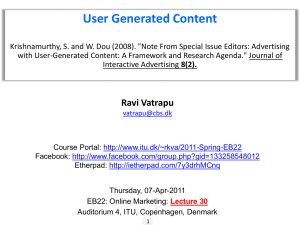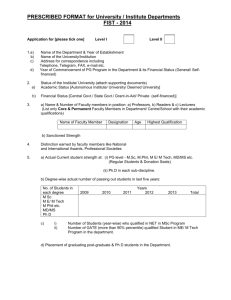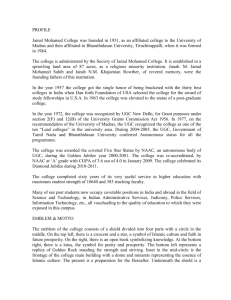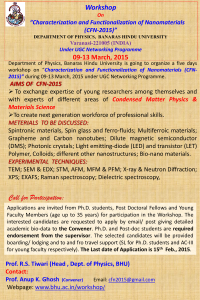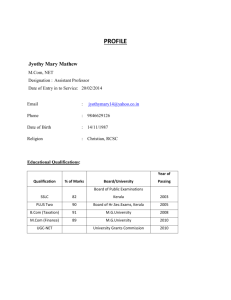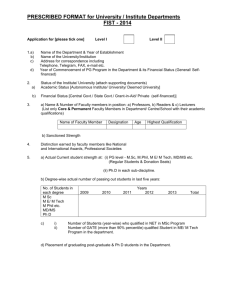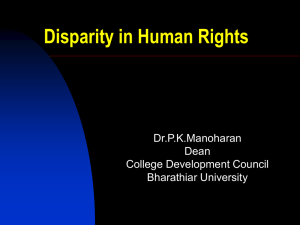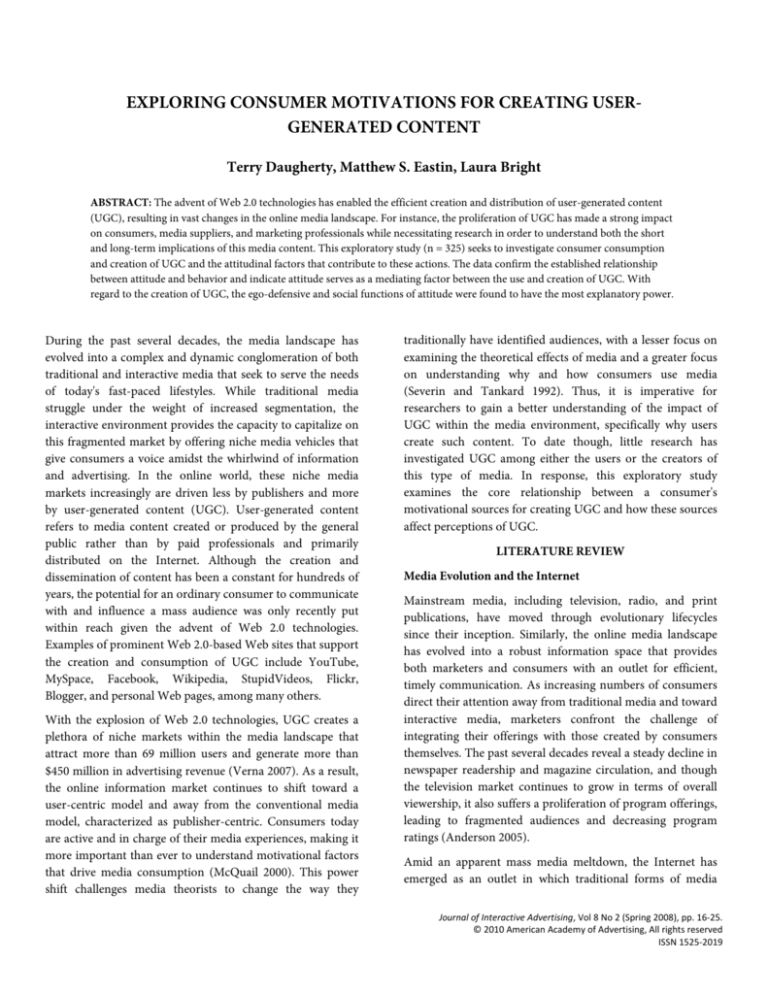
EXPLORING CONSUMER MOTIVATIONS FOR CREATING USERGENERATED CONTENT
Terry Daugherty, Matthew S. Eastin, Laura Bright
ABSTRACT: The advent of Web 2.0 technologies has enabled the efficient creation and distribution of user-generated content
(UGC), resulting in vast changes in the online media landscape. For instance, the proliferation of UGC has made a strong impact
on consumers, media suppliers, and marketing professionals while necessitating research in order to understand both the short
and long-term implications of this media content. This exploratory study (n = 325) seeks to investigate consumer consumption
and creation of UGC and the attitudinal factors that contribute to these actions. The data confirm the established relationship
between attitude and behavior and indicate attitude serves as a mediating factor between the use and creation of UGC. With
regard to the creation of UGC, the ego-defensive and social functions of attitude were found to have the most explanatory power.
During the past several decades, the media landscape has
evolved into a complex and dynamic conglomeration of both
traditional and interactive media that seek to serve the needs
of today's fast-paced lifestyles. While traditional media
struggle under the weight of increased segmentation, the
interactive environment provides the capacity to capitalize on
this fragmented market by offering niche media vehicles that
give consumers a voice amidst the whirlwind of information
and advertising. In the online world, these niche media
markets increasingly are driven less by publishers and more
by user-generated content (UGC). User-generated content
refers to media content created or produced by the general
public rather than by paid professionals and primarily
distributed on the Internet. Although the creation and
dissemination of content has been a constant for hundreds of
years, the potential for an ordinary consumer to communicate
with and influence a mass audience was only recently put
within reach given the advent of Web 2.0 technologies.
Examples of prominent Web 2.0-based Web sites that support
the creation and consumption of UGC include YouTube,
MySpace, Facebook, Wikipedia, StupidVideos, Flickr,
Blogger, and personal Web pages, among many others.
With the explosion of Web 2.0 technologies, UGC creates a
plethora of niche markets within the media landscape that
attract more than 69 million users and generate more than
$450 million in advertising revenue (Verna 2007). As a result,
the online information market continues to shift toward a
user-centric model and away from the conventional media
model, characterized as publisher-centric. Consumers today
are active and in charge of their media experiences, making it
more important than ever to understand motivational factors
that drive media consumption (McQuail 2000). This power
shift challenges media theorists to change the way they
traditionally have identified audiences, with a lesser focus on
examining the theoretical effects of media and a greater focus
on understanding why and how consumers use media
(Severin and Tankard 1992). Thus, it is imperative for
researchers to gain a better understanding of the impact of
UGC within the media environment, specifically why users
create such content. To date though, little research has
investigated UGC among either the users or the creators of
this type of media. In response, this exploratory study
examines the core relationship between a consumer's
motivational sources for creating UGC and how these sources
affect perceptions of UGC.
LITERATURE REVIEW
Media Evolution and the Internet
Mainstream media, including television, radio, and print
publications, have moved through evolutionary lifecycles
since their inception. Similarly, the online media landscape
has evolved into a robust information space that provides
both marketers and consumers with an outlet for efficient,
timely communication. As increasing numbers of consumers
direct their attention away from traditional media and toward
interactive media, marketers confront the challenge of
integrating their offerings with those created by consumers
themselves. The past several decades reveal a steady decline in
newspaper readership and magazine circulation, and though
the television market continues to grow in terms of overall
viewership, it also suffers a proliferation of program offerings,
leading to fragmented audiences and decreasing program
ratings (Anderson 2005).
Amid an apparent mass media meltdown, the Internet has
emerged as an outlet in which traditional forms of media
Journal of Interactive Advertising, Vol 8 No 2 (Spring 2008), pp. 16‐25. © 2010 American Academy of Advertising, All rights reserved ISSN 1525‐2019 17 Journal of Interactive Advertising Spring 2008
entertainment can converge and offer consumers content at
the time and place most convenient for them. Media scholars
acknowledge that traditional media models of communication
may no longer adequately represent digital media, for which
"convergence" may serve as an increasingly more accurate
representation (Perry 2002). With online usage expanding
annually, the Internet has come to serve as a media outlet for
an overwhelming majority of American adults (i.e., 71%)
(Verna 2007). Although traditional media are nowhere near
extinction, trends clearly are changing, such that consumers
are in greater control of their media consumption, and
audiences face the opportunity to make media content choices
themselves rather than rely on traditional gatekeepers (Perry
2002).
The emergence of the Internet, by its very nature, has
enhanced content and file sharing applications, which in turn
have shaped the creation and distribution mechanisms for
UGC. Over time, the Internet has become a highly
personalized information space in which consumers can tailor
their media exposure to their specific needs and desires
(Liang, Lai, and Ku 2006). Tailored exposures become
possible through Web-based applications that aggregate
information and UGC according to their subscriber's
specifications, which again indicates consumer-centric media
exposures rather than publisher-centric ones. As the
consumption, creation, and distribution of UGC continues to
evolve, content aggregation tools and Web 2.0 applications
built on Really Simple Syndication (RSS) technology will
become more usable and accessible to consumers, helping
create a manageable information space that is both
customized and relevant. The ability to publish content in the
online environment has been possible since the inception of
the Internet, because personal publication mechanisms are
inherent to the structure of this information space. However,
constant, organic growth and change is what leads to an
information explosion online and the creation of UGC.
Ultimately, a balance of power between message producers
and media audiences has been lacking for years, and UGC
potentially represents a power shift within the industry. The
trend toward greater control means media theorists must
focus more on understanding audience motivations for
consuming media content as users are confronted with more
choices today than ever before (Severin and Tankard 1992).
Motivational Sources for Creating UGC
Media consumption represents a deliberate, active behavior in
which audiences seek content according to their internal
motivations (Eastin and Daugherty 2005). These internal
motivations represent functional sources designed to meet
specific consumer needs and serve as the foundation for
attitude formation, ultimately influencing behavior (O'Keefe
2002). A person's attitude represents a psychological
tendency, expressed by evaluating a particular object, and can
serve various motivations (Eagly and Chaiken 1993). In terms
of media use, a consumer's willingness to experience UGC
depends on his or her attitude toward the consumption or
creation of UGC. However, because individual motivations
can vary greatly, consumers may decide to consume, or more
specifically create, UGC for different reasons, which is
precisely the justification for this study.
Katz's (1960) seminal work on functional theory is considered
by many essential for understanding the complex
motivational underpinnings and functions of attitude.
Functional theory states that attitudes serve various
motivations, depending on the purpose, such that one's
behavior becomes a function of their attitude toward that
behavior (O'Keefe 2002). The basis of this theory centers
around the view that to influence behavior, we must
understand its motivational source (i.e., attitude). Overall,
theorists widely accept functional theory as a robust
framework for recognizing diverse motivational sources
(Abelson and Prentice 1989; Herek 1987; Locander and
Spivey 1978). Katz's (1960) typology posits that any given
attitude serves one or more of four distinct personality
functions: utilitarian, knowledge, ego-defensive, and valueexpressive functions. The utilitarian function acknowledges
that people are motivated to gain rewards and avoid
punishment from their environment. Specifically, this
function represents attitudes based on self-interest. In terms
of UGC, consumers served by this motivational source create
UGC primarily for their own personal incentives. In contrast,
the knowledge function recognizes that people are driven by
the need to gain information to organize and understand their
environment. That is, we are motivated by the need to
understand and make sense of our experiences. Creators of
UGC therefore would produce UGC because it helps them
understand their environment, the topic at hand, and/or
ultimately themselves, because they feel a sense of intrinsic
wisdom. The value-expressive function entails attitudes that
allow people to express or relate their self-concepts and
values, which enhance one's image in the eyes of the world
through matching moral beliefs. Thus, creators of UGC feel
inherently gratified with a sense of self-esteem because they
have created content and become members of an online
18 Journal of Interactive Advertising Spring 2008
community that shares the principles they consider
important. It validates and helps them feel good about who
they are and what they believe about the world. Finally, the
ego-defensive function represents motivations designed to
protect people from internal insecurities or external threats,
which serve the internal function of defending one's selfimage. In this case, UGC creators participate to minimize
their own self-doubts, feel a sense of belonging, and possibly
reduce guilty feelings about not contributing.
Although these four functions remain the core constructs for
understanding attitudinal motivations, contemporary
researchers continue to clarify and explore additional
contributions. For example, Smith (1973) proposes an
extension of the value-expressive function, focused on the
motivation for social adjustment, in which people express
attitudes or behavior that are agreeable to others. The
function also has evolved to include motivations derived from
relationships with others and recognizes the distinction
between internal beliefs and the desire for external
relationships, independent of moral values. In particular, the
social function compels people to seek opportunities to
interact with friends or participate in activities perceived
favorably by important others (Clary et al. 1998). In terms of
the creation of UGC, the social function would be a strong
motivator, because concepts of sharing and interacting
socially are widespread. In turn, UGC creators and consumers
might be motivated by this function because of how their
important reference groups would perceive their membership
in such an online community.
Even though each functional source may make independent
motivational contributions to the formation of one's attitude,
the theoretical assertion remains that a person's attitude
results from a multitude of origins and likely is driven by a
combination of sources (Katz 1960). This study attempts to
expand the understanding of the creation of UGC by
investigating consumer's motivations and subsequent
attitudes from within the functional theory framework. We
thus propose:
H1: A consumer's functional source of motivation relates
positively to his or her attitude toward creating UGC
content.
Attitude -> Behavior Relationship
The motivational sources driving media consumption depend
on the formation of positive or negative attitudes toward a
medium. However, because virtually everyone in the United
States engages in daily media consumption, media researchers
often end up comparing attitudes and experiences with media
(i.e., behavior) using a reciprocal relationship perspective
(Perry 2002). According to Myers (1998), the attitude>behavior relationship can range from nonexistent to very
strong, such that attitude about a given object determines the
person's interactions with that object. Although varying
degrees of strength can exist in the attitude->behavior
relationship, Fazio (1986) identifies three key components for
the development of an attitude: (1) affection, (2) cognition,
and (3) behavioral intention. The affective and cognitive
components of an attitude center around a consumer's
feelings, beliefs, and ultimate evaluation of the object, whereas
the behavioral component accounts for the action, if any, the
consumer takes. As it relates to UGC, a consumer's attitude
derives from both the perceived value of the content and how
it relates to his or her existing beliefs and feelings (i.e.,
motivational sources).
To parse out the development of attitudes and their
relationship to behavior, Fazio and Towles-Schwen (1999)
present an integrated framework of the attitude behavior
process called the "MODE" model, which classifies two
processes that guide the attitude-behavior relationship:
spontaneous processing and deliberative processing. In a
situation that involves spontaneous processing, consumers
react and form an attitude based on their "perceptions of the
object in the immediate situation" (Fazio and Towles-Schwen
1999, p. 97). Generally, this immediate situation depends on
environmental triggers that cue a memory for the consumer
and indicate an impending behavior. Any resulting behavior
indicates the consumer's attitude at that given time and
depends on the immediacy of the situation, as well as the
accessibility of memories about such a situation (i.e., personal
theory). In contrast, the deliberative processing approach does
not focus on preexisting attitudes provoked by environmental
cues but instead draws on the raw data present in a given
situation. With deliberative processing, people form their
attitudes on the basis of a data evaluation; specifically, "it
involves consideration of the specific attitude object and the
potential consequences of engaging in a particular behavior"
(Fazio and Towles-Schwen, 1999 p. 100). Although it is
difficult to imagine a situation in which personal theories of
action do not apply to a certain degree, the deliberative
approach is decidedly more applicable to UGC, because it
involves data-driven decisions based on aggregated content.
Specific objects requiring evaluation change rapidly when
examining UGC, but the act of consuming such content
19 Journal of Interactive Advertising Spring 2008
results from a consumer's attitude toward such an activity and
the technological components with which he or she interacts
to obtain such content. Given a positive interaction with a
given piece of UGC, a consumer's attitude toward its
consumption and creation should become more positive.
The deliberative processing route lends itself well to the
consumption of UGC, whereas the spontaneous processing of
attitude objects applies better to the creation of UGC.
Spontaneous processing of attitudes relies on personal
theories of action associated with environmental triggers that
cue memories, which suggest an attitude and course of action
needed. The act of creating UGC therefore depends on
attitude toward both previous experiences with UGC and the
immediacy of the situation that involves its creation. In this
regard, consumers must have positive attitudes toward UGC
in general to prompt their positive reaction to a situation in
which they can create their own UGC. Provided a positive cue
exists, we expect the likelihood of UGC creation to increase as
positive exposures to UGC increases.
A consumer's attitude also may affect both the creation and
consumption of UGC independently, though we know little
about how attitude may explain this relationship.
Nevertheless, research has attempted to clarify how attitudes
moderate the relationship between exposure to an attitude
object and ultimate behavior, but few studies address how
attitude might mediate such a relationship. Spivey, Munson,
and Locander (1983) seek to determine which sources of
attitude affect the relationship between exposure to
advertising and purchase intention by manipulating the
advertising content to serve different aspects of Katz's (1960)
functional sources of attitude. They conclude that messages
are more likely to induce attitude change if they match the
primary functional factor that determines a consumer's
attitude. According to their research, a consumer's attitude
toward a given object depends on its relationship with the
consumer's "primary functional profile" (Spivey, Munson, and
Locander 1983, p.267). Therefore, a consumer's attitude
toward UGC should derive partially from how well UGC
maps to his or her functional attitude schema. That is, we
propose a connection between a consumer's attitude toward
consuming and creating UGC. Even though these behavior
types are distinct, the reciprocal nature of the attitude>behavior relationship suggests that a consumer's reinforced
attitude mediates the relationship between the behaviors, such
that consumption of UGC precedes creation, as we depict in
Figure 1.
Figure 1. Consumer Attitude->Behavior Relationship
Involving UGC
Behavior ultimately is influenced by the attitude of the
consumers who experience it; therefore, we must explicate a
more complete conceptualization of the elements of such
attitudes. Understanding how a consumer's attitude
influences his or her behavior may have significant
explanatory power in distinguishing the relationship between
the consumption and creation of UGC.
H2: A consumer's attitude toward UGC mediates the
relationship between his or her consumption and creation
of UGC.
METHOD
Sample and Procedure
A survey was administered to an opt-in subject pool recruited
for Web-based research (i.e., online panel). Data was gathered
from 325 participants over a seven-day period with 1,000 email invitations sent on day one, 1,500 on day three, and 500
on day 5. The survey was closed once 325 completed surveys
were recorded (day seven). Because a purposive sample was
selected based on sample size, response rate was not
calculated since the survey was closed after being open for the
designated duration. However, the completion rate, defined as
those who completed the survey divided by those who
accessed it, was 77%.
DESIGN
An 82-item questionnaire was developed and pre-tested on a
small sample of academic professionals to ensure clarity. In
addition, because UGC is an emerging form of media content,
a conceptual definition was provided as a reference for
respondents to interpret the questionnaire:
User-generated content (UGC) refers to media content that is
created or produced by the general public rather than by paid
professionals and is primarily distributed on the Internet.
This includes such online content as digital video, blogging,
20 Journal of Interactive Advertising Spring 2008
podcasting, mobile phone photography, wikis, and userforum posts, among others.
Measured Variables. Measures include self-reported media
usage, attitude toward UGC, type of UGC experienced, how
often respondents create UGC, the five functional sources of
attitude toward UGC, and basic demographic variables.
Media Use. Media use (i.e., consuming UGC) was recorded
via a self-reported ‘average time spent per day' item, as well as
creating UGC. To assess the type of UGC most commonly
experienced, prevalent categories previously identified were
selected (i.e., videos, pictures, audio, blogs, drawings,
discussion forums, personal Web sites, and wikis).
Attitude toward UGC. Attitude toward UGC was measured
using an established four-item seven-point semantic
differential
scale
(unpleasant/pleasant,
unappealing/appealing,
unpleasant/pleasant,
not
enjoyable/enjoyable) with higher values represent a more
positive attitude (Bruner, James, and Hensel 2001).
Function Sources. Functional sources of attitude were
derived from established scales found in the literature and
restated to match the context of this study. Each of the items
were seven-point Likert type scales anchored by strongly
disagree (1) and strongly agree (7). To assess the utilitarian
function, respondents were asked to indicate their level of
agreement with three-items focused on identifying whether
they create UGC because it benefits them personally, because
it helps them get what they want, and because it allows them
to get as much out of the Internet as they can (Bosnjak and
Batinic, 2002; Gastil, 1992). In turn, the knowledge and egodefensive functions were measured by scales adopted from
Clary et al (1998). The three knowledge items used measured
respondent's agreement with whether they learn more about
things when creating UGC, whether they are able to gain a
new perspective on things when creating UGC, and whether
creating UGC enables them to learn things through direct,
hands on experience. The three-item ego-defensive measures
assessed agreement with the notion that creating UGC makes
them feel important, increases their self-esteem, and makes
them feel needed. Subsequently, the three-item valueexpressive function was measured by ascertaining
respondent's level of agreement with statements such as
creating UGC is consistent with my most basic beliefs, I feel
morally obligated to create UGC, and creating UGC reflects
my moral beliefs (Gastil, 1992). Finally, the social function of
attitude was measured by assessing three-items focused on the
agreement with whether creating UGC is a good way to meet
people, is a great way to make new friends, and creating UGC
makes them feel like a part of a community (Clary et al.,
1994). In order to minimize response bias, all subsequent
items were randomly ordered.
RESULTS
Data Analyses
The sample consists of 50.5% men and 49.5% women with the
largest portion (25.8%) falling between the ages of 35 to 44
years (M = 44.3). Most respondents classified themselves as
Caucasian (82.5%) while attending some college (32.9%) with
a household income ranging from $20,001 to $40,000 (28.3%).
For a complete profile of the sample characteristics see the
appendix.
Eighty-seven percent of respondents reported experiencing at
least one type of UGC while spending on average 55.66
minutes each day consuming this type of media content. To
parse consumption out further, respondents were asked to
delineate which types of UGC they consume on a regular
basis. The findings reveal that viewing pictures online
(51.1%), watching videos (48.9%), and browsing personal web
sites (25.5%) are the most common categories of UGC
experienced (Table 1). In turn, UGC creators represented
21.84% of the sample and spend on average 112 minutes, or
just under two hours, creating UGC on a typical day. The
creators of UGC also exhibited interesting patterns in their
creation of UGC: 44% have contributed pictures to the UGC
community, roughly 41% have created a blog, 46.5% have
participated in a discussion forum, and 42.3% have created
their own website (Table 1). Thus, most UGC content
creation appears to be in the realm of text and photos with
video, audio, and drawing creations slightly less popular.
Overall, respondent's reported a moderately favorable attitude
toward UGC overall (M = 4.2, SD = 1.38,α=.93). Furthermore,
the knowledge (M = 4.45, SD = 1.36) and social (M = 4.36, SD
= 1.39) motivational sources were identified as the most
favorable descriptively (Table 2). All functional sources of
attitude measures were tested for internal consistency and a
specified factor structure based on theory-driven indicators
using principal components factor analysis. The analysis was
performed in order to verify that the items used were indeed
measuring different functions. Reliability assessment was
conducted using Cronbach's Alpha with each scale (Social α =
.93; Ego-Defensive α = .96; Knowledge α = .95; Utilitarian α =
.85; Value-Expressive α = .87) exceeding the generally
accepted guideline of .70 (Hair et al. 1998).
21 Journal of Interactive Advertising Spring 2008
Table 1. Consumption of UGC by Type for Consumers and
Creators of UGC
Table 2. Attitude toward UGC Across Functional Sources
for Creators of UGC
Hypothesis Testing
Hypothesis one posits that a consumer's functional source of
motivation relates positively to his or her attitude toward
creating UGC content. Using multiple regression to test this
relationship within the realm of UGC, we find significance
(F(5,70) = 5.19, p < .01; R2 = .29), in support of the
hypothesis. However, when examining the contribution of
each individual function, we find significant relationships for
only three of the five motivational sources. Specifically,
creators of UGC rely predominantly on the ego-defensive
function (β = .42, t(5,70) = 2.38, p < .05) and social function
(β = .34, t(5,70) = 2.54, p < .01) as their motivational sources
when forming attitudes toward UGC. In contrast, a negative
relationship was discovered with the value-expressive
function (β = -.43, t(5,70) = -2.89, p < .01) and no significant
relationships for the utilitarian (β = .17, t(5,70) = 1.26, p > .05)
and knowledge (b = -.07, t(5,70) = -.48, p > .05) functions in
contributing to participants' attitude toward UGC creation.
Hypothesis two states that a consumer's attitude toward UGC
should mediate the relationship between consumption and
creation. To determine whether attitude mediates the
relationship between the consumption and creation of UGC,
an analysis was conducted as specified by Baron and Kenny
(1986). To establish mediation, (1) the consumption of UGC
must positively affect the mediator (attitude toward UGC); (2)
consumption of UGC must positively affect the dependent
variable (creating UGC); and (3) the mediator must positively
affect the dependent variable when regressed in conjunction
with the independent variable. When these conditions are
met, the effect of the independent variable on the dependent
variable also must be lesser in the third step than in the
second step (Baron and Kenny 1986).
The first analysis indicates that consumption positively
influences a consumer's attitude toward UGC (β = .39, t(324)
= 7.52, p < .01, R2 = .15). Furthermore, consumption
positively influences the creation of UGC (β = .33, t(70) =
2.93, p < .01,R2= .11). Finally, the third analysis indicates that
attitude (β = .25, t(2,70) = 2.01, p < .05) mediates the
relationship between the consumption and creation
dimensions of UGC (F(5,70) = 6.51, p < .01; R2 = .16).
Accordingly, the effect of consumption on the creation of
UGC weakens when included in the analysis with attitude (β
= .23, t(2,70) = 1.88, p > .05). Thus, a consumer's attitude
serves as a mediator in the relationship between consumption
and creation of UGC, in support of the hypothesis.
DISCUSSION
As UGC becomes more prevalent, understanding why
consumers are drawn to create content becomes increasingly
important, especially as the media industry moves toward a
user-centric model of consumption. Identifying motivational
sources that influence the formation of consumer attitudes
toward UGC also may result in a more robust predictive
model of audience behavior, which is increasingly important
to both scholars and industry professionals. As a result, it is
imperative to gain an understanding of how consumer
attitudes interact with motivational sources for the creation of
UGC to recognize how such content might benefit advertisers
and marketers.
The ego-defensive and social functional sources contribute
significantly to attitudes formulated about the creation of
UGC. The ego-defensive function specifically compels people
to protect themselves from internal insecurities and external
threats, and the creation of UGC in this sense helps
consumers minimize their self-doubts and feel a sense of
community. The social function assists consumers in seeking
out activities that are perceived as favorable by important
others and gives them the opportunity to associate with
friends. In relation to the creation of UGC, consumers engage
in such actions to connect with others and feel important.
Even though we identify a negative relationship between the
value-expressive function and a consumer's attitude toward
UGC, this is not necessarily a surprising result given the
conceptual construct. Value expressiveness reflects internal
moral beliefs, often associated with serious or controversial
22 Journal of Interactive Advertising Spring 2008
topics and issues (e.g., religion, political positions). However,
most types of UGC offer entertainment, focused on humor
and light-hearted topics (Verna 2007). This claim is not to
suggest that content reflecting moral beliefs is not created and
distributed online but rather that this type of content tends to
be professionally produced.
One unforeseen result is the noticeable difference between
UGC creation and consumption behavior. Our findings
indicate that consumers are substantially more likely to create
blogs, post within discussion forums, and construct Web sites
than simply to consume these forms of UGC. In contrast,
UGC audiences are more inclined to watch videos, view
pictures, listen to audio, and visit wiki sites when experiencing
UGC rather than when creating such content. These findings
are intriguing in the sense that they suggest different
motivations or expected outcomes associated with specific
behaviors. Although content control remains a strong
advantage of the Internet, UGC users appear more inclined to
treat these vehicles like traditional sources and adopt a passive
approach. In contrast, UGC creators strive toward selfexpression by engaging in behaviors that provide them with a
voice or showcase their individual thoughts (e.g., blogs,
forums, personal Web sites). These differences also may
simply reflect the impact of individual skill or self-efficacy.
For example, the creation of videos, production of music, and
acquisition of necessary knowledge to post a wiki require
more aptitude than simply using a computer keyboard (i.e., as
required by an online discussion forum). Nevertheless, the
differences between these two activities demand more
investigation to provide a more thorough understanding.
In addition, these findings confirm the relationship between a
consumer's attitude and behavior toward a given attitude
object (i.e., consumption and creation of UGC). Determining
this positive relationship is critical as we attempt to
investigate the effects of the consumption and creation of
UGC on both consumer behavior and marketing efforts. This
relationship suggests that as a consumer's attitudes toward
UGC strengthens, the consumption and creation of such
content increases, while being mediated by attitude. This
finding spotlights the importance of creating positive
customer experiences with UGC, in terms of both products
offered and content provided by marketers to promote goods
and services through UGC.
Any study contains inherent limitations that affect the overall
validity and reliability of the results. With regard to this
research, a few limitations should be considered when
interpreting the findings. For example, a purposive sample
was used that does not represent the Internet population as a
whole. Although strong consideration was taken in the choice
of an online panel to collect data for this study, little control
was given to the researchers in terms of sampling.
Nevertheless, the objective of this research was not to
generalize findings to the entire online panel universe but
rather to explore the relationships among the proposed
theoretical constructs. In addition, another limitation is the
extremely broad definition of UGC used in this study. In
considering this definition, it is possible that respondents
could have over-reported consumption and creation of UGC.
CONCLUSIONS
This study attempts to expand the knowledge of UGC by
testing the motivations for creating UGC. This framework is
important to both scholars and practitioners because the
Internet can serve as a more powerful medium than
traditional media, in the sense that consumers now may
consume, interact with, control, create, and distribute media
content. As UGC becomes more prevalent, identifying the
motivational reasons for creating such media also becomes
increasingly important. Therefore, understanding consumer
attitudes toward UGC, especially motivational sources, should
result in a better model of behavior, which is increasingly
important to researchers focused on Internet marketing.
From a theoretical perspective, we offer what Calder, Phillips,
and Tybout (1981) refer to as an "effects application" of
theory. That is, the observed data help identify functional
sources of motivation for creating UGC rather than
specifically assessing the status of or extending an existing
theoretical framework. It is not that the findings fail to
enhance our understanding of functional theory (Katz 1960);
rather the purpose is to examine a current phenomenon
through an established theoretical framework instead of
testing a theoretical framework to provide a general
understanding of the world (Calder and Tybout 1999).
Research conducted from this perspective relies on the notion
of theoretical explication to verify and replicate previous
research in different contexts (Chaffee 1996). Unquestionably,
the confirmation of ego-defensive, social, and valueexpressive functional sources of motivation and their
contributions to the attitude formation toward creating UGC
offers a positive theoretical affirmation. The next step is to
identify how these motivational sources differ in affecting the
consumption of UGC and whether additional sources exist.
23 Journal of Interactive Advertising Spring 2008
Furthermore, the managerial implications of this research are
immediate as the ability to develop brand relationships via
social experiences through UGC, and the means to deliver
persuasive messages to consumers who experience or create
UGC, represents the future of marketing. This research
successfully connects functional theory and sources of
motivation with attitudes toward UGC. Specifically, egodefensive and social functional sources are serving as strong
contributors toward attitudes formulated for creating UGC.
The ego-defensive function recognizes that people have selfdoubts that they seek to minimize. Likewise, the socialfunction drives people to spend time with others and
experience a sense of community. Marketers must understand
these motivations for consuming this form of media and
either strive to provide similar content creation opportunities
or advertise on popular UGC sites to reach these consumers.
Each of the functional sources can make motivational
contributions to the formulation of a consumer's attitude.
Although utilitarian and knowledge based functions do not
appear to provide significant contributions, these findings do
not mean that future UGC categories or consumer
preferences might not adopt these motivational sources at
some point. Therefore, a thorough understanding of the
psychological makeup of UGC consumers is even more
critical because the creation and delivery of promotional
messages might be refined for maximum impact. By
providing consumers with a forum in which they may create
and distribute their own UGC, marketers might enhance the
value of the brand information they present by engaging
consumers in an active media experience.
The UGC content market likely will expand greatly during the
next decade as more users migrate toward consuming and
creating UGC. Furthermore, as the digital information society
continues to evolve, identifying key motivational sources that
lead to functional changes in or the reinforcement of attitudes
can help clarify media consumption online. Therefore, an
essential component of success in this market will be
determining the key motivational factors that reinforce
attitudes toward and increase the consumption and creation
of UGC. Opportunities abound for both advertisers and
marketers in this burgeoning information space, as evidenced
by the forecasted $4.3 billion in advertising revenues by 2011
(Verna 2007). Marketers thus must seize this opportunity to
communicate relevant content to audiences through this
channel. Of course, this single study represents just a first step
in a new and unexplored area of online consumer behavior,
and continued work must verify and validate these results to
provide a full understanding of the impact of UGC.
REFERENCES
Abelson, R. P. and D.A. Prentice (1989), "Beliefs as
Possessions: A Functional Perspective," in Attitude Structure
and Function,, A.R. Pratkanis, S.J. Breckler, and A.G.
Greenwald, eds. Hillsdale, NJ: Lawrence Erlbaum Associates,
361-81.
Anderson, Chris (2006), The Long Tail: Why the Future of
Business is Selling Less of More, London: Random House
Business Books.
Baron, Reuben M. and David A. Kenny (1986), "The
Moderator-Mediator Variable Distinction in Social
Psychological Research: Conceptual, Strategic, and Statistical
Considerations," Journal of Personality and Social Psychology,
51(6), 1173-1182.
Bosnjak, M. and B. Batinic (2002), "Understanding the
Willingness to Participate in Online-Surveys-The Case of EMail Questionnaires," in Online Social Sciences, B. Batinic, U.
Reips, and M. Bosnjak, eds. Seattle: Hogrefe & Huber
Publishers.
Bruner, Gordon C., K.E. James, and P.J. Hensel (2000),
Marketing Scales Handbook: A Completion of Multi-Item
Measures, Vol. III. Chicago, IL: American Marketing
Association.
Calder, Bobby J., Lynn W. Phillips, and Alice M. Tybout
(1981), "Designing Research for Application," Journal of
Consumer Research, 8(September), 197-207.
--- and Alice M. Tybout (1981), "A Vision of Theory,
Research, and the Future of Business Schools," Journal of the
Academy of Marketing Science, 27(3), 359-366.
Chaffee, Steven H. (1996), "Thinking About Theory," in An
Integrated Approach to Communication Theory and Research,
Michael B. Salwen and Don W. Stacks, eds. Mahwah, NJ:
Lawrence Erlbaum Associates, 15-32.
Clary, E.G., M. Snyder, R. Ridge, J. Copeland, A. Stukas, J.
Haugen, and P. Miene (1998), "Understanding and Assessing
the Motivations of Volunteers: A Functional Approach,"
Journal of Personality and Social Psychology, 74(6), 1516-1530.
---, ---, ---, P. Miene and J. Haugen (1994), "Matching
Messages to Motives in Persuasion: A Functional Approach to
24 Journal of Interactive Advertising Spring 2008
Promoting Volunteerism," Journal
Psychology, 24(13), 1129-1149.
of
Applied
Social
Perry, David K (2002), Theory and Research in Mass
Communication: Contexts and Consequences, 2d ed. Mahwah,
NJ: Lawrence Erlbaum Associates.
Eastin, Matthew S. and Terry Daugherty (2005), "Past,
Current, and Future Trends in Mass Communication," in
Marketing
Communication:
Emerging
Trends
and
Developments, Allan Kimmel, ed. Oxford: Oxford University
Press.
Severin, Werner J. and James W. Tankard Jr. (1992),
Communication Theories: Origins, Methods, and Uses in the
Mass Media, 3d ed. White Plains, NY: Longman Publishing
Group.
Eagly, Alice H. and Shelly Chaiken (1993). The Psychology of
Attitudes, Fort Worth, TX: Harcourt Brace Janovich College
Publishers.
Smith, M.B. (1973), "Political Attitudes," in Handbook of
Political Psychology, J. Knutson, ed. San Francisco: JosseyBass, 57-82.
Fazio, Russell H. (1986), "How Do Attitudes Guide Behavior?"
in Handbook of Motivation and Cognition, R.M. Sorrentino
and E.T. Higgins, eds. New York: Guilford, 204-43.
Spivey, W. Austin, J. Michael Munson, and William B.
Locander (1983), "Improving the Effectiveness of Persuasive
Communications: Matching Message with Functional
Profile," Journal of Business Research, 11, 257-269.
--- and T. Towles-Schwen (1999), "The MODE Model of
Attitude-Behavior Processes," in Dual Process Theories in
Social Psychology, S. Chaiken and Y. Trope, eds. New York:
Guilford, 97-116.
Verna, Paul (2007), "User-Generated Content: Will Web 2.0
Pay Its Way?" eMarketer, June 2007, 1-31.
APPENDIX : RESPONDENT PROFILE
Gastil, J. (1992), "Why We Believe in Democracy: Testing
Theories of Attitude Functions and Democracy," Journal of
Applied Social Psychology, 22(6), 423-450.
Hair, John F., Rolf E. Anderson, Ralph L. Tatham, and W.C.
Black (1998), Multivariate Data Analysis, 5th ed. Upper
Saddle River, NJ: Prentice Hall.
Herek, Gregory M. (1987), "Can Functions Be Measured? A
New Perspective on the Functional Approach to Attitudes,"
Social Psychology Quarterly, 50(4), 285-303.
Katz, Daniel (1960), "The Functional Approach to the Study
of Attitudes," Public Opinion Quarterly, 24, 27-46.
Liang, Ting-Peng, Hung-Jen Lai, and Yi-Cheng Ku (2006),
"Personalized Content Recommendation, Management
Information Systems, 23(3), 45-70.
Locander, W. B. and W.A. Spivey (1978), "A Functional
Approach to Attitude Measurement," Journal of Marketing
Research, 15(4), 576-587.
McQuail, Denis (2000), McQuail's Mass Communication
Theory, 4th ed. Thousand Oaks, CA: Sage Publications.
ABOUT THE AUTHORS
Myers, David G. (1998) Social Psychology, 9th ed. New York:
McGraw-Hill.
O'Keefe, Daniel J. (2002), Persuasion: Theory & Research 2d
ed.Thousand Oaks, CA: Sage Publications.
Terry Daugherty (Ph.D., Michigan State University) is an
Assistant Professor in the Department of Advertising and CoDirector
of
the
Media
Research
Lab
<http://mediaresearch.communication.utexas.edu/> at The
University of Texas at Austin. His research focuses on
25 Journal of Interactive Advertising understanding consumer psychology by investigating
strategic, social, and technological issues involving the mass
media with work appearing in the Journal of Advertising,
Journal of Computer-Mediated Communication, Journal of
Consumer Psychology, Journal of Interactive Advertising,
Journal of Interactive Marketing, and the International
Journal of Internet Marketing and Advertising, among
numerous
other
scholarly
publications.
Email:
Terry.Daugherty@mail.utexas.edu.
Matthew S. Eastin (Ph.D., Michigan State University) is an
Associate Professor in the Department of Advertising and CoDirector
of
the
Media
Research
Lab
<http://mediaresearch.communication.utexas.edu/> at The
University of Texas at Austin. Dr. Eastin1s research focuses on
investigating information processing as well as the social and
psychological factors associated with new media behavior
including game play involvement, media adoption, ecommerce, and e-health. Dr. Eastin1s work can be found in
the Journal of Communication, Communication Research,
Human Communication Research, Journal of Broadcasting &
Electronic Media, CyberPsychology & Behavior, Journal of
Computer-Mediated Communication, and Computers in
Human
Behavior,
to
name
a
few.
Email:
Matt.Eastin@mail.utexas.edu.
Laura Bright (Ph.D. Candidate., University of Texas at
Austin) is a doctoral student in the Department of
Advertising at The University of Texas at Austin. Her
research interests focus on interactive media, digital content
management and understanding consumer consumption of
media. Email: lbright@seedling.com.
Spring 2008

